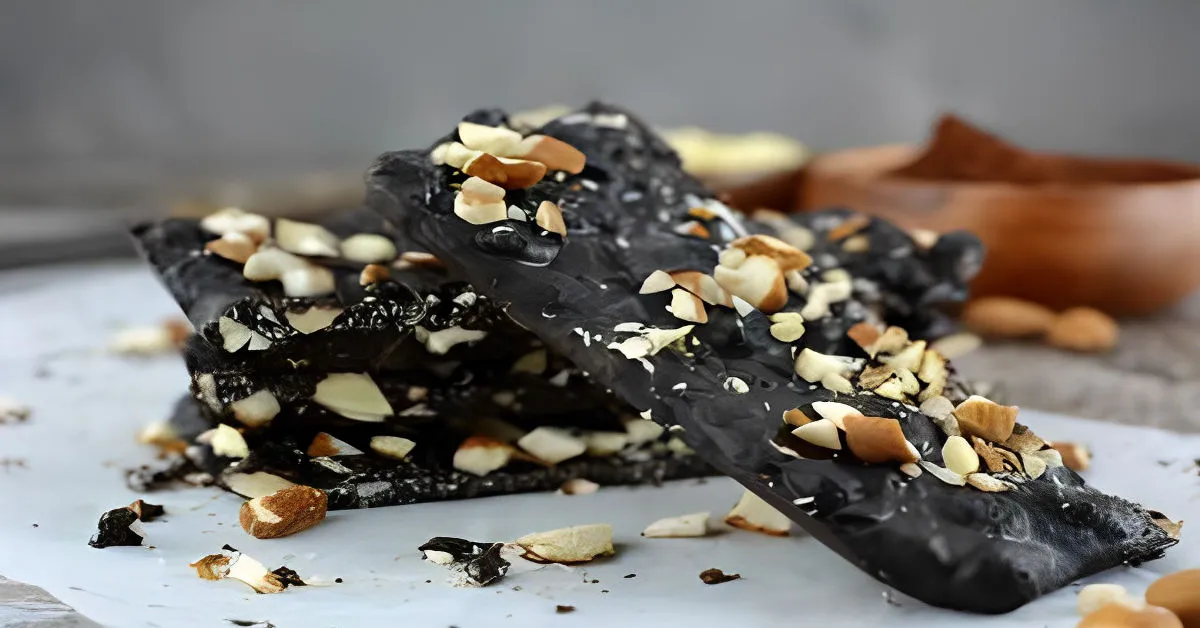Diving into the world of chocolates, we often stumble upon delightful variations that tantalize our taste buds in unexpected ways. Among these, almond bark chocolate stands out as a versatile and indulgent treat that has captured the hearts of many. This article aims to unwrap the layers of chocolate almond bark , exploring its origins, varieties, and the myriad ways it can be used to add a touch of sweetness to our lives. From health benefits to homemade recipes, we’ll delve into everything you need to know about this delightful confection. So, let’s embark on this chocolatey journey, shall we?
Introduction to Almond Bark Chocolate
What is Almond Bark Chocolate?
Almond bark chocolate, a confection that’s as rich in history as it is in flavor, is a true delight for anyone with a sweet tooth. At its core, almond bark is a smooth, chocolatey concoction that’s studded with the crunchy goodness of almonds. This treat is not just about the taste; it’s a blend of textures that dance together in perfect harmony. Whether you’re a fan of dark or milk chocolate, the addition of almonds elevates the experience, making it a versatile ingredient in various desserts.
Exploring the Types and Varieties of Almond Bark Chocolate
Dark vs. Milk Almond Bark
When it comes to chocolate almond bark , the debate between dark and milk chocolate is as old as time. On one hand, dark almond bark offers a rich, intense chocolate flavor that pairs beautifully with the natural bitterness of almonds. It’s a match made in heaven for those who crave a deeper, more sophisticated taste. On the other hand, milk almond bark provides a sweeter, creamier experience, where the milk chocolate’s velvety texture complements the crunchy almonds, creating a harmonious blend that melts delightfully in your mouth.
Flavored Almond Bark Varieties
But why stop at dark and milk chocolate? The world of almond bark is vast, with a plethora of flavored varieties that add an extra layer of excitement to this classic treat. Imagine the zest of orange peel embedded in almond bark, or the subtle warmth of vanilla enhancing its chocolatey goodness. There’s even a place for bold adventurers willing to try almond bark with a hint of sea salt or chili, offering a tantalizing contrast that tickles the palate. These flavored varieties not only cater to diverse taste preferences but also open up a whole new realm of culinary possibilities.
As we explore the different types and varieties of almond bark chocolate, it’s clear that this confection is more than just a treat; it’s a canvas for creativity. Whether you lean towards the classic dark or milk chocolate almond bark, or you’re eager to experiment with flavored varieties, there’s no denying the allure of this versatile confection. With each type offering its unique blend of flavors and textures, it continues to captivate the hearts (and taste buds) of chocolate lovers around the world.
Health Benefits and Nutritional Information
Nutritional Value of Almond Bark Chocolate
Diving into the nutritional landscape of almond bark chocolate, it’s fascinating to uncover the blend of indulgence and health benefits packed within each bite. Almonds, the star ingredient, are a powerhouse of nutrients, offering protein, fiber, and essential vitamins and minerals such as vitamin E, magnesium, and potassium. When these nutritional gems are enveloped in chocolate, the result is not only delicious but also beneficial to your health. Dark chocolate, in particular, is renowned for its antioxidants, which can support heart health and provide anti-inflammatory benefits.
Health Benefits of Almonds in Almond Bark
The inclusion of almonds in almond bark chocolate isn’t just a win for flavor and texture; it’s also a boon for your health. Almonds can help in managing weight, thanks to their protein and fiber content that promote satiety. They’re also beneficial for heart health, as they contain monounsaturated fats known to reduce cholesterol levels. Moreover, almonds are a great source of antioxidants, which protect against oxidative stress, reducing the risk of chronic diseases. Combining these healthful nuts with the antioxidant properties of dark chocolate makes almond bark chocolate a snack that’s not only satisfying but also somewhat nutritious.
DIY Almond Bark Chocolate Recipes
Basic Ingredients and Tools Needed
Embarking on the journey to create your own almond bark chocolate at home starts with gathering a few basic ingredients and tools. You’ll need high-quality chocolate, either dark or milk depending on your preference, and a generous handful of whole almonds. To ensure your almond bark has that professional touch, consider roasting the almonds slightly to enhance their nutty flavor. As for tools, a microwave-safe bowl or a double boiler for melting the chocolate, a baking sheet lined with parchment paper, and a spatula for spreading the chocolate are essential. With these simple ingredients and tools, you’re well on your way to creating homemade almond bark that rivals any store-bought version.
Step-by-Step Guide to Making Almond Bark
Making almond bark chocolate at home is surprisingly straightforward and immensely satisfying. First, you’ll want to melt the chocolate until it’s smooth and glossy. You can do this using a microwave, stirring at 30-second intervals to avoid burning, or use a double boiler for more controlled heating. Once melted, fold in the roasted almonds, ensuring they’re evenly coated in the chocolate. Then, pour the mixture onto your prepared baking sheet, spreading it to your desired thickness. A little tip: tapping the baking sheet on the counter will help remove any air bubbles and even out the surface.
Let the almond bark cool and harden, which you can expedite by placing it in the refrigerator. Once set, break it into pieces using your hands for a rustic look, or cut it with a knife for more uniform shapes. Voila! You’ve just made your very own almond bark chocolate, ready to be enjoyed or shared as a thoughtful homemade gift.
Tips for Perfect Almond Bark Every Time
Achieving perfection with your almond bark chocolate comes down to a few key tips. First, quality matters; using high-quality chocolate makes all the difference in flavor and texture. Also, don’t rush the cooling process; allowing the almond bark to set slowly at room temperature can result in a smoother finish, though the fridge works well if you’re short on time. Lastly, feel free to get creative with add-ins and toppings. While almonds are the star, a sprinkle of sea salt, dried fruit, or a drizzle of white chocolate can add an extra layer of flavor and make your almond bark uniquely delicious.
With these steps and tips, making almond bark chocolate at home becomes not just a culinary activity but a creative outlet, allowing you to tailor this delightful treat to your taste preferences and share the joy of homemade chocolate with others
Creative Ways to Use Almond Bark Chocolate
Desserts and Sweet Treats
Almond bark chocolate doesn’t just shine as a standalone treat; it also plays a starring role in a variety of desserts and sweet creations. Imagine drizzling melted almond bark over fresh strawberries or using it as a decadent layer in your homemade truffles. The possibilities are endless and utterly delicious. For a crowd-pleaser, consider almond bark chocolate-dipped pretzels, where the salty crunch of the pretzel pairs perfectly with the sweet and nutty chocolate. Or, for a more sophisticated twist, almond bark shavings can add a gourmet touch to your favorite tiramisu or cheesecake, offering a delightful texture contrast and a boost of chocolatey flavor.
Almond Bark as a Gift
Beyond its versatility in the kitchen, almond bark chocolate also makes for a thoughtful and personalized gift. Whether it’s for a holiday, a special occasion, or just because, homemade almond bark wrapped in elegant packaging shows care and consideration. You can customize each batch with the recipient’s favorite nuts or dried fruits, making it a truly unique present. Pairing your almond bark with a handwritten recipe card not only adds a personal touch but also encourages the recipient to try their hand at this delightful treat. Gifting chocolate almond bark is a sweet way to spread joy and share your culinary creations with friends and family.
Almond bark chocolate’s adaptability extends far beyond the basic recipe, transforming ordinary desserts into extraordinary treats and serving as a heartfelt gesture when given as a gift. Its simplicity, combined with the potential for customization, makes chocolate almond bark a favorite among home cooks and chocolate lovers alike. So, the next time you’re looking for a way to sweeten up your dessert menu or searching for the perfect gift, remember that it offers a world of possibilities just waiting to be explored.
Storing and Preserving Almond Bark Chocolate
Best Practices for Longevity
To ensure your almond bark chocolate maintains its quality and deliciousness over time, proper storage is key. First off, you’ll want to keep it in a cool, dry place, away from direct sunlight. Chocolate has a tendency to absorb odors, so it’s crucial to store it in an airtight container to preserve its original flavors. If you live in a warmer climate or it’s a hot summer day, consider storing your almond bark in the refrigerator. However, make sure to wrap it tightly in plastic wrap or aluminum foil, then place it in an airtight container to prevent any moisture from seeping in, which could spoil the texture.
For those who have made a large batch and are looking at longer storage options, freezing almond bark chocolate is a fantastic solution. When freezing, wrap the almond bark in several layers of protection—plastic wrap, then aluminum foil, and finally, place it in a freezer-safe bag or container. This method can keep your almond bark fresh for up to six months. When you’re ready to enjoy it, let it thaw gradually in the refrigerator to prevent any condensation from forming, which could affect its texture and taste.
Frequently Asked Questions
Can almond bark chocolate be used for baking?
Absolutely! Almond bark chocolate is not only a delightful treat on its own but also a versatile baking ingredient. You can chop it into chunks and add it to cookie dough or brownie batter for a nutty chocolate twist. It melts beautifully, making it perfect for chocolate ganache or as a decadent drizzle over cakes and pastries. The key is to gently melt the almond bark to avoid scorching, ensuring a smooth texture for your baked goods.
How to melt almond bark chocolate without burning?
Melting almond bark chocolate is a breeze if you follow a couple of simple steps. First, break or chop the almond bark into uniform pieces to ensure even melting. You can use a microwave, heating in short bursts of 20-30 seconds and stirring in between, or opt for a double boiler on the stove, stirring constantly. The trick is low and slow; never rush the process with high heat, as chocolate can burn easily, affecting its taste and texture.
Is almond bark chocolate gluten-free?
Generally, it can be gluten-free, but it’s crucial to check the ingredients list. While the primary components, chocolate and almonds, are naturally gluten-free, some almond bark recipes or store-bought versions might contain additives or be processed in facilities that handle gluten-containing products. For those with gluten sensitivities or celiac disease, seeking out specifically labeled gluten-free almond bark or making it at home with known ingredients is the safest bet.
Ingredients for Homemade Almond Bark Chocolate
- Chocolate of Choice: 16 ounces (about 450g)
- You can use dark, milk, or white chocolate, depending on your preference. For a richer flavor and health benefits, dark chocolate is recommended.
- Whole Almonds: 1 cup (about 143g)
- Opt for raw almonds if you plan to roast them yourself for added crunch and flavor. Alternatively, you can use roasted almonds (unsalted) if you prefer.
- Optional: Sea Salt, a pinch for sprinkling on top before the chocolate sets, to enhance the flavor.
Optional Ingredients for Customization:
- Dried Fruits: Such as cranberries or cherries, for a sweet and tart contrast.
- Other Nuts: Like pecans, walnuts, or cashews, for added texture and flavor diversity.
- Flavorings: Vanilla extract or orange zest to infuse the bark with aromatic flavors.
- Toppings: Sprinkles, crushed candy canes, or a drizzle of a different type of chocolate for decoration and extra flavor layers.
In wrapping up our journey through the delightful world of chocolate almond bark , we’ve uncovered the rich history, diverse varieties, and numerous ways to enjoy this versatile treat. From its health benefits to the joy of crafting it in your own kitchen, almond bark chocolate stands out as a testament to the simple pleasures in life. Whether you’re indulging in a piece for a sweet treat, using it to elevate your baking creations, or gifting it to spread some joy, it offers a world of possibilities. Armed with the knowledge and inspiration from this guide, you’re now ready to explore the delicious potential of almond bark chocolate in all its forms. Happy indulging!


